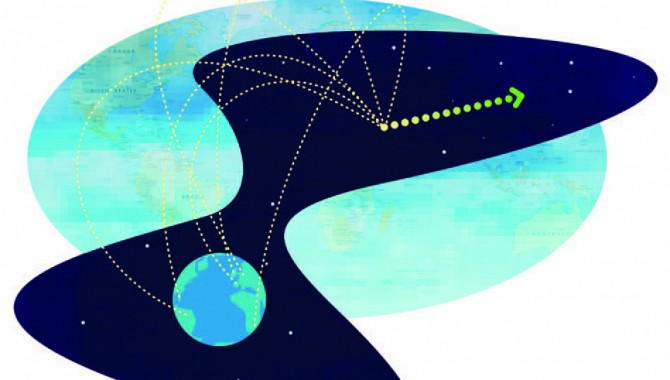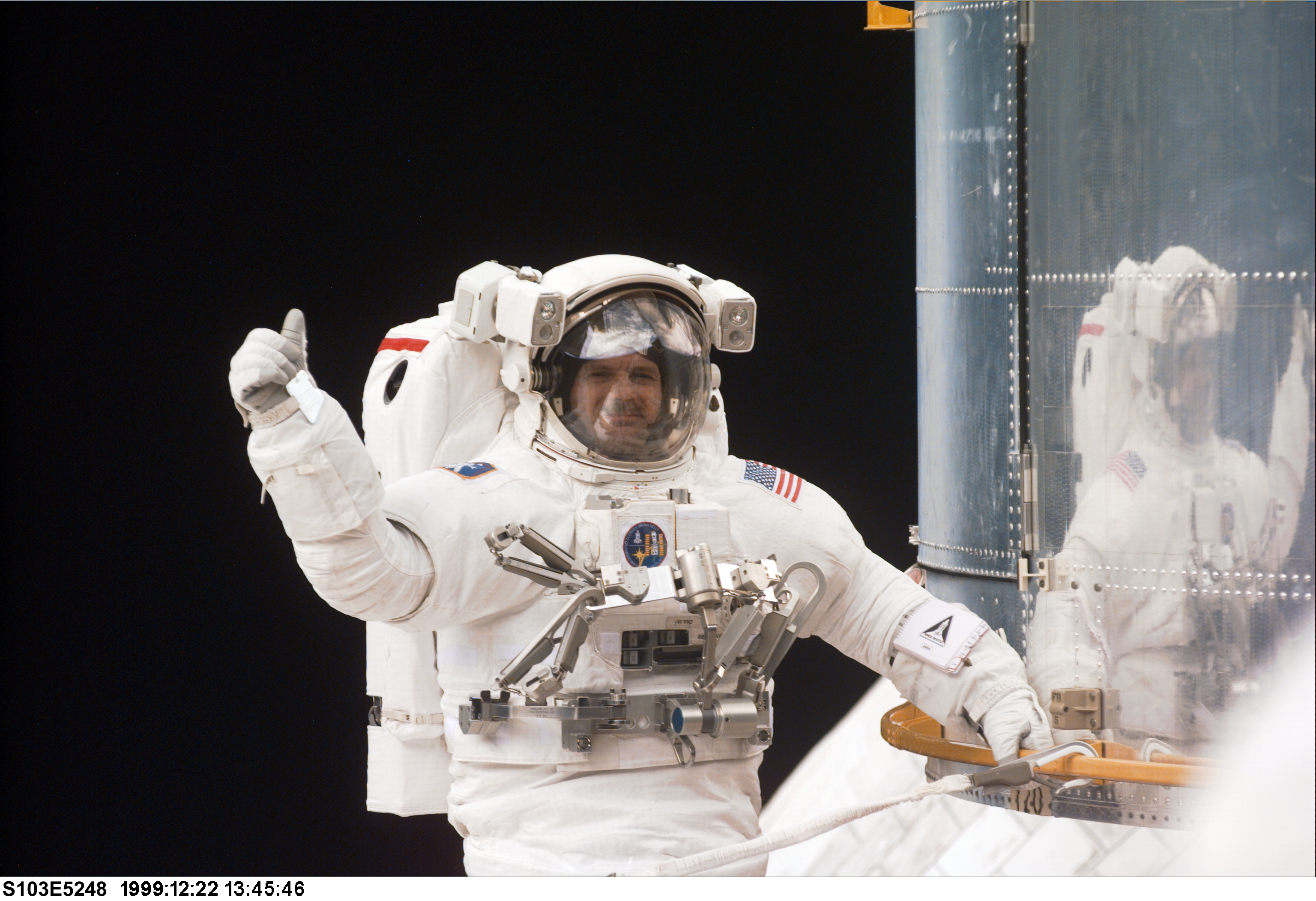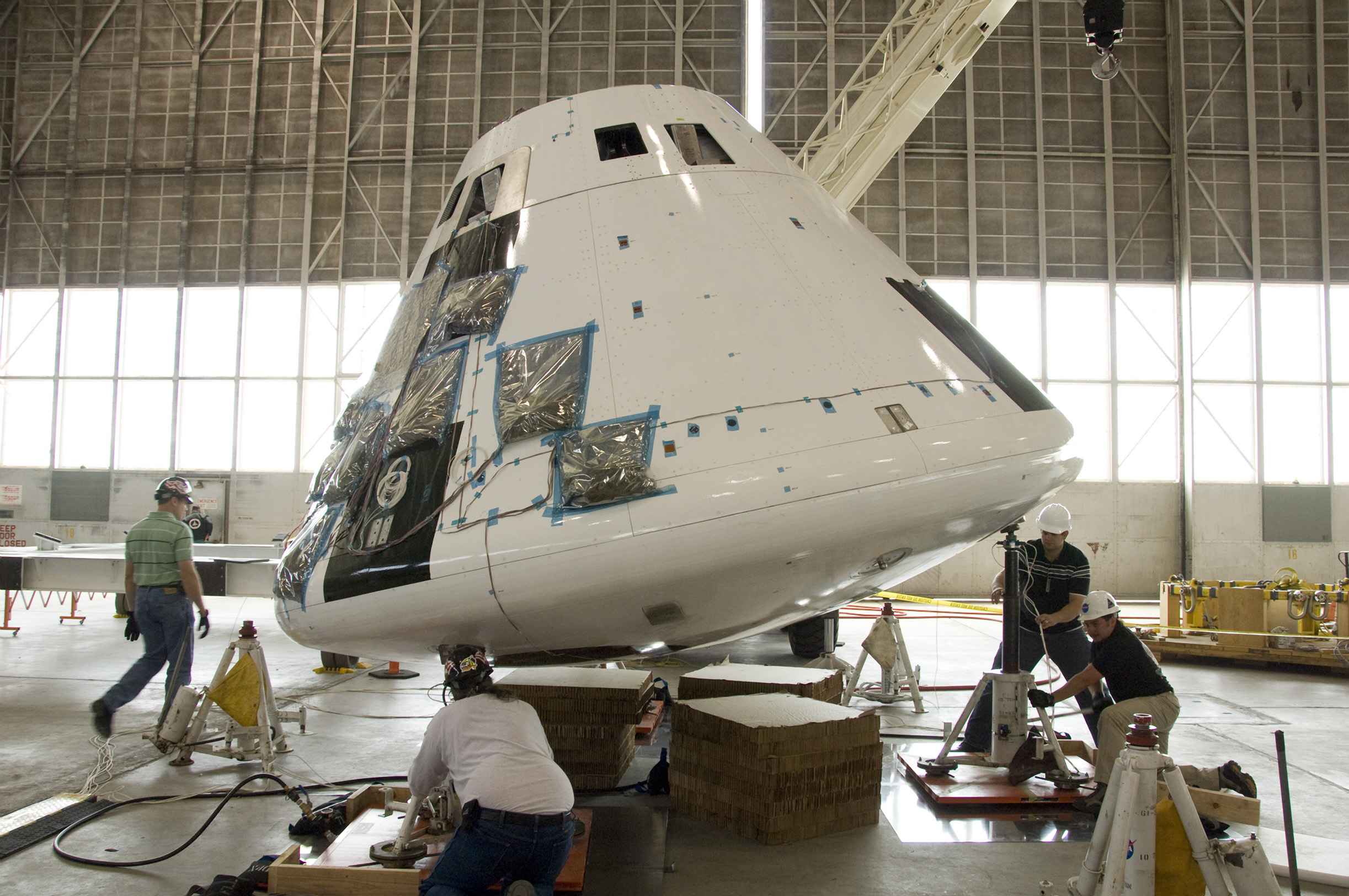
By Kathy Laurini
The year is 2050. The vicinity around Earth has become a vibrant economic sphere. Physical sciences and medical research in space are driving innovations that enable companies to offer new products that improve our quality of life. Tourists spend summer vacations beyond the atmosphere. Humans and robots are working together to service the space-based assets on which the global economy continues to depend. Beyond Earth orbit, we have established an outpost on the planet Mars—a visiting research station where scientists from around the world come to pursue answers to questions about Mars’s atmosphere and climate changes to better understand the future of our own planet. People visit the moon from time to time to service a deep-space observatory or extract a precious resource. We are prepared to mitigate the risk of dangerous asteroid collisions with our planet. In short, we have extended our human presence across the solar system “for the benefit of all mankind” (words from the National Aeronautics and Space Act of 1958, which created NASA).
That human spaceflight brings worldwide benefits of knowledge, innovation, and inspiration is widely recognized both within the United States and around the globe. That view recognizes fifty years of human spaceflight achievements and the thriving international partnerships that built and operate the International Space Station (ISS). There is international consensus that the next step will be a global partnership for human exploration of our solar system, and that the time to start planning for this future is now.
NASA wants to continue to lead in human spaceflight. Our partners count on us to lead. How can we lead in this environment where we rely on international partner contributions to accomplish the basic mission? What can we do to ensure NASA can lead effectively? I hope to provide some useful insights, gained over thirty years of working with international partners on the Space Shuttle, ISS, and Constellation programs. I offer some lessons that I hope help managers to ensure their international programs or projects are successful.
NASA’s Strategic Plan
The 2011 NASA Strategic Plan establishes extending and sustaining human activities across the solar system as one of the agency’s six strategic goals. This long-term goal calls for the development of an integrated architecture and capabilities for safe crewed and cargo missions beyond low-Earth orbit. The strategic plan recognizes that human presence cannot be extended without the capabilities and resources of our international and commercial partners. By including the importance of expanding international partnerships in its overarching strategy, NASA recognizes the increased complexity of future missions and challenges us to define and build the necessary partnerships.
Nations with emerging spaceflight programs such as India and South Korea will be important partners in the future.
To me, expanding our international partnerships means building stronger relationships with the partners we have today and looking for opportunities to build new partnerships. I believe we must succeed in both areas if we want to lead the effort to extend and sustain human presence in space.
There are two keys to strengthening our existing partnerships. First, we must remain reliable partners, following through with our obligations and informing partners early when we have issues. Second, as we plan for the future, we should involve them in the exploration-planning process. Consulting them and incorporating their ideas and capabilities in the development of an integrated architecture will bring robustness to the missions we plan together. This is happening today within the Human Exploration and Operations Mission Directorate, which is working to develop a human-spaceflight Global Exploration Roadmap. As part of this effort, representatives from twelve space agencies are working on mission scenarios of expanding human presence, with Mars as a driving long-term goal. All the current ISS partner agencies are engaged and contributing.
Nations with emerging spaceflight programs such as India and South Korea will be important partners in the future. The work on the Global Exploration Roadmap is one example of initiatives that we will need to build lasting relationships with them, like those we have with our ISS partners.
Some Lessons Learned
In my experience, programs and projects with international agencies are most likely to be successful when you and your international counterpart are committed to the joint project. Understanding the specific programmatic and technical complexities and developing strategies to jointly manage them is important. While you may control the most significant portion of the budget needed for success, the investment of your partner is probably as great or greater, as a proportion of his agency’s overall budget. You and your counterpart should commit to maintaining regular communication, establishing timely decision-making mechanisms, and trusting each other to raise issues as early as possible. With these high-level considerations in mind, here are some other, more specific, things to look out for and think about.
Create Opportunities to Build Relationships
In 1993, the decision was made to expand the space station partnership to include the Russians. Bringing this new partner, whom many remember as an old adversary, into the program changed many things. When the Russians joined, the original space station partners—NASA, Canadian Space Agency (CSA), European Space Agency (ESA), and Japan Aerospace Exploration Agency (JAXA)—had been working together for more than five years under NASA’s leadership to settle requirements, define interfaces, distribute functions, and deal with other aspects of the cooperative venture. NASA’s relationship with CSA and ESA, based on shared shuttle-program experience, was very strong. Our relationship with JAXA was developing well.
NASA program managers defined a phased approach to bring the Russians on board. Phase 1 involved cooperative initiatives within both NASA’s and Russia’s individual operational programs. NASA astronauts were to fly to the Mir space station. Russian cosmonauts were to fly on the Space Shuttle. The Space Shuttle was to fly around and eventually dock with Mir. Each of these missions involved a lot of planning, meetings, travel, and expense. You could argue that the benefits we gained from any individual mission may not have justified the cost. Taken together, however, those Phase 1 activities allowed us to build relationships necessary to continue leading the ISS program and working well with Russian partners. Engineers, managers, and astronauts spent time in Russia; many learned Russian and began to understand Russian culture both at work and outside work. We learned how the Russians made decisions, solved problems, and found creative ways to fund their effort during a difficult time in Russia, after perestroika.
There were also more modest opportunities to learn about one another and build trust. They included demonstration of ISS-related technologies, defining and validating interface standards, and joint development of precursor capabilities.
Lesson 1: Create large and small opportunities for people to build relationships, understanding, and trust.
Dont Assume It Has to Cost More to Partner
People like to say it will cost more to partner than to do it all alone. It doesn’t have to be this way. It is true that there will be some additional costs associated with working internationally, and you must pay attention to export control and International Traffic in Arms Regulations. But a significant cost driver is the level of oversight assigned to all the critical design and development activities of your partner or partners.
Long experience working with our traditional partners has shown us that we can rely on them to deliver excellent products. Let’s use this experience to streamline how we work together. In the early days of the space station program, we went through a very time-consuming process of examining the design and construction specifications of our partners to be sure they met or exceeded our standards. This process took man-years to complete and resulted in a discipline-by-discipline understanding of their approach to requirements definition, design, testing, and verification.
Lesson 2: Recognize that past experiences of NASA with traditional partner agencies will provide a good basis for building the relationships and trust needed to execute your project successfully and cost effectively.
Understand the Cultural Differences
Differences in culture within the work environment and outside work will exist between you and your partner agencies. Understanding and working effectively with the differences will help make your joint program or project successful. Within the work environment, what are roles and responsibilities of key players? How do they make decisions? Who decides? For bigger projects, embedding a technical liaison is a good idea. I served in this capacity for the ISS program. By being collocated with ESA, I developed a deep understanding of their work culture and the relationships among ESA countries, as well as with NASA. That knowledge helped us overcome some challenges early in the ISS program.
Understanding and respecting the national culture is also important. People from different countries have different ways of looking at things and different ways of expressing their opinions or desires. For example, the Japanese will typically avoid directly expressing a negative answer. When JAXA colleagues say “that will be difficult,” it usually means it’s impossible and I’d be wasting my time trying to lessen the burden of a particular approach and should instead start looking for a compromise. Being familiar with the differences can avoid misunderstandings and make interactions more effective.
Lesson 3: Take the time to understand the relevant cultures of your partners, both work and national cultures.
The Shared Future of Space Exploration
International partnerships will be important to NASA’s human spaceflight future. We need to lead—and partner—effectively. Establishing early, critical-path roles for our partners will be important for them and us, and is likely to lead to increased stakeholder support. Creating effective partnerships that bring their technical strengths, resources, and capabilities to bear will increase the robustness of our architectures in ways that increase the probability of mission success.
In the famous words of Yuri Gagarin: Poyekhali!—Let’s go!
About the Author
 |
Kathy Laurini is a senior advisor within NASA’s Exploration Systems Mission Directorate, where she contributes to the development and implementation of strategies for international partnerships in space exploration. She has thirty years of experience within NASA’s human spaceflight effort, including leadership positions within the International Space Station and Constellation programs. |









